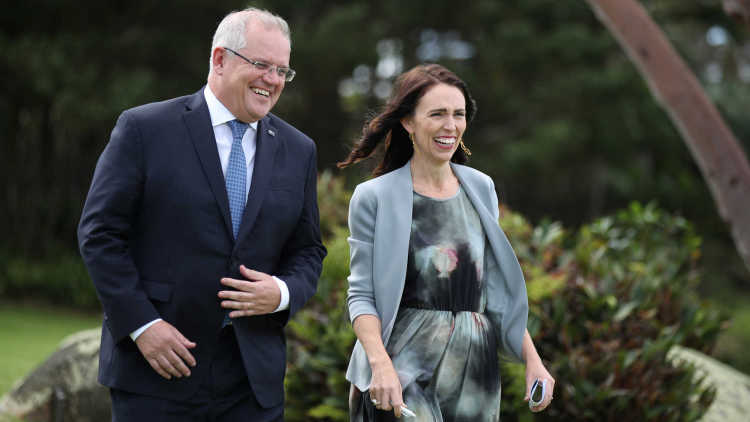- Startseite
- Presse
- Vom Lockdown zur regionalen Blase? Wie Australien und Neuseeland die Erholung von COVID-19 im Südpazifik unterstützen können
Kurz notiert | 05.06.2020
Vom Lockdown zur regionalen Blase? Wie Australien und Neuseeland die Erholung von COVID-19 im Südpazifik unterstützen können
After having experienced one of the strictest lockdowns worldwide in the face of the COVID-19 pandemic, the five million residents of New Zealand are on their way to a return to normal life.

With no new infections for well over two weeks and no active case, bigger gatherings such as weddings and concerts will be possible again. Even professional rugby matches and other big sports events attended by numerous spectators will follow in mid-June. After having experienced one of the strictest lockdowns worldwide in the face of the COVID-19 pandemic, the five million residents of New Zealand are soon likely to move to “alert level 1,” meaning that most things – except for travelling to and leaving the country – will once again be allowed.
In Australia, New Zealand’s much bigger neighbour (indeed, its only real one in a genuine sense), the government was initially a bit late to recognise the exigencies of the unfolding COVID-19 crisis. As recently as late February, Prime Minister Scott Morrison declared that the virus should not prevent people from gathering in large crowds to attend sports events. Soon thereafter, however, Australia adopted a similarly strict response to the outbreak as New Zealand. Aided by a low number of initial infections and the inherent advantages of island states with small populations, the respective governments in Canberra and Wellington responded vigorously to the COVID-19 pandemic, identifying relevant local clusters and averting a major spread of the virus throughout each of their countries. Effectively, the two Australasian allies marched in lockstep during the height of the pandemic, displaying a high degree of coordination and engaging in crucial exchange at various levels of government, from PMs Scott Morrison and Jacinda Ardern down through the respective layers of the two federal governments.
The ability of New Zealand and Australia to align their COVID-19 responses was certainly helped by the fact that no other major countries – except for the member states of the European Union – are as closely integrated as Australia and New Zealand. The two states have made much progress in moving towards a single economic market, and joint ministerial meetings take place across the Tasman Sea on a regular basis. The free movement of people between Australia and New Zealand has been possible since the early 1970s on the basis of the Trans-Tasman Travel Arrangement, which allows, with a few restrictions, citizens of each country to visit, work, and live in the other country indefinitely. Given the much bigger size of the Australian economy (and the ensuing greater opportunities it affords), more New Zealanders than Australians have made use of the arrangement: an estimated 650,000 Kiwis – more than 15 per cent of the population – currently reside in Australia.
Though COVID-19 temporarily halted this smooth back-and-forth across the Tasman Sea, its return within the next few months is on the cards. Morrison and Ardern committed in early May 2020 to introducing a trans-Tasman COVID-safe travel zone as soon as it is secure to do so. The two leaders noted the mutual benefit of such an arrangement: it would assist in the recovery of trade and other economic sectors, kick-start the tourism and transport sectors, enable families and friends to reunite, and – this being Australia and New Zealand, after all – enhance sporting contacts. Importantly, the two PMs also reached out to the other countries in the South Pacific, offering to explore travel arrangements with interested countries once Australia and New Zealand themselves had agreed to all relevant transport and other protocols to ensure the protection of public health. Effectively, the trans-Tasman bubble would widen into a broader regional bubble. The South Pacific is a huge but sparsely populated world region. Despite being richly endowed with Blue Economy resources, the Pacific island countries (PICs) face many development challenges. Climate change even poses an existential threat to some of the region’s microstates.
For the other members of the Pacific Islands Forum (to which Australia and New Zealand also belong), a regional safe-travel bubble in the face of COVID-19 would be more than welcome, given the pandemic’s drastic impact on their economies, which tend to be highly dependent on tourism and remittances. Take the example of Fiji, which, with a population of close to one million, has to be considered one of the region’s two “heavyweights” (along with Papua New Guinea). Fiji – like other PICs – has brought the local spread of the virus under control, with just three officially registered active cases as of late May. But tourism, which accounts for approximately 40 per cent of Fiji’s GDP, has virtually come to a standstill. Two-thirds of the tourists coming to Fiji are the half-million Australians and New Zealanders who visit the country annually. The creation of a regional bubble could also see a much larger number of seasonal workers from the PICs travelling to Australia and New Zealand, sending much-needed remittances back home.
While everything possible must be done to prevent a second wave – or, in the case of the Cook Islands and Tuvalu, a first wave – of infection being brought into the PICs from Australia and New Zealand (and vice versa), the creation of a regional bubble should remain high on the political agendas of Canberra and Wellington. Australia and New Zealand’s traditional dominance in the South Pacific has been slowly eroded by the growing influence of China, which offers alternative funding and policy options to PICs. China’s links with the Pacific have grown substantially since the turn of the decade. Trade, investment, loans, the Belt and Road Initiative, and other ties have left a sizeable footprint. To try to compensate for China’s expanding regional profile, Australia and New Zealand have, respectively, “stepped up” and “reset” their relations with the PICs since 2018, increasing aid and intensifying diplomatic efforts. Whereas Australia tends to focus on Melanesia and New Zealand on Polynesia, both countries share an interest in promoting regional integration, free trade, and security. Although their respective diplomatic styles and particular outlooks on the region differ somewhat, Australia and New Zealand have repeatedly engaged in joint action in the Pacific. In this time of great need, Australia and New Zealand can once again demonstrate cooperative regional leadership. They should join hands with the other Pacific nations by extending their planned trans-Tasman bubble to interested countries in the region, helping them to cushion the effects of the COVID-19 pandemic on their economies.
On NZ's narrative in the pandemic in comparison with Germany, see ORF Special Report by Prof. Dr. Amrita Narlikar, p. 5.
